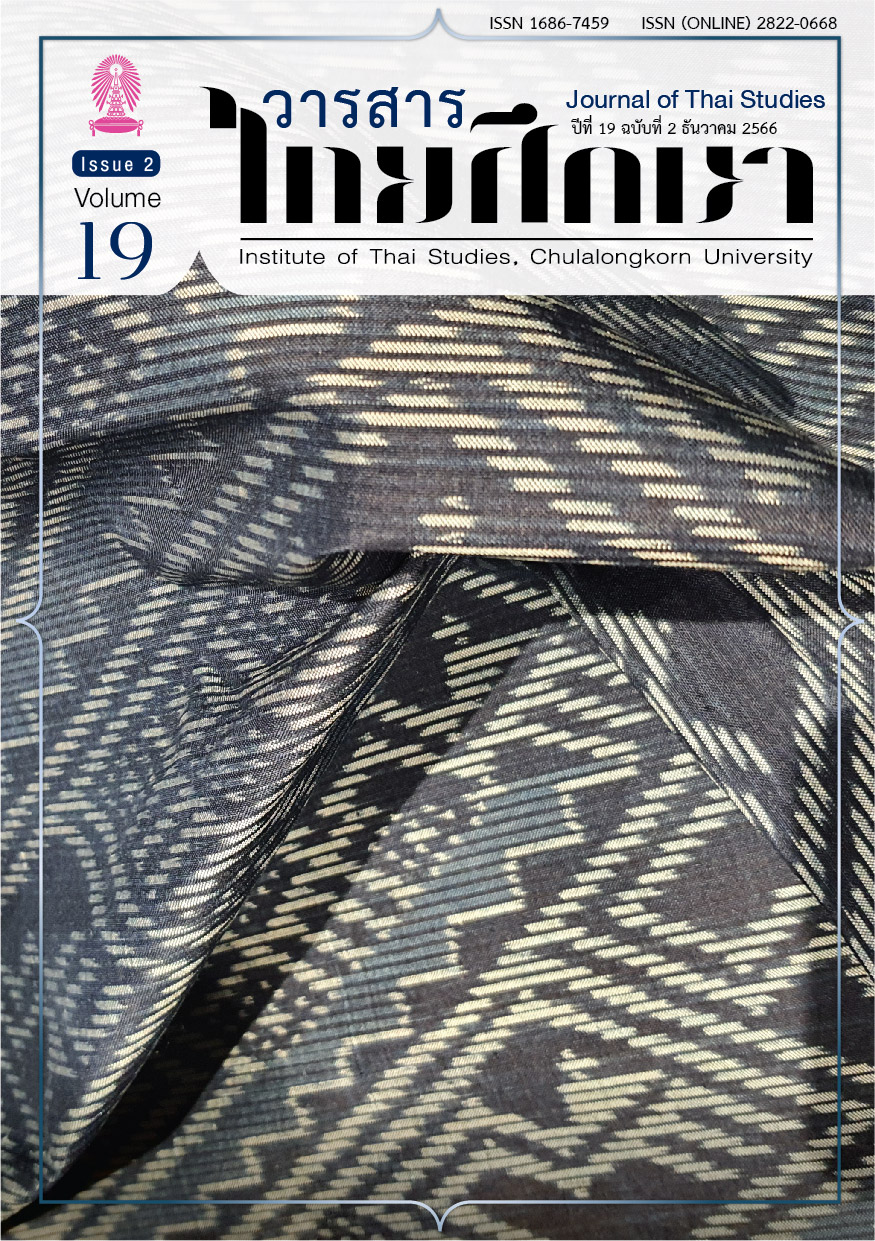An Analysis of Local Art Identity and Mutelu Beliefs for the Development of Art Activities : A Case Study of Nan's Textile Handicraft
Main Article Content
Abstract
Background and objective: Nan province has tourist attractions based on various cultures, particularly the local textile handicrafts. In addition to being beautiful with colors and delicate weaving, various patterns also interpolate meanings that reflect the beliefs of the Nan people. This is consistent with the trend of participants today, who seek a mental anchor. The purpose of this research was to analyze and discover the relationship between Nan's textile handicraft identity and Mutelu beliefs for the development of art activities.
Methodology: The sample group was experts in Nan textile handicraft, Nan's textile handicrafts and research related to the Nan's textile handicrafts. The research tools were interviews and a survey of the Nan textile handicrafts. Data were collected by interviewing experts in weaving art in Nan province and studying textile art patterns. Then the identity of Nan's textile handicrafts was analyzed to find ways to use folk art identity for the development of art activities. Data were analyzed by percentage and content analysis.
Main result: 1) The art patterns of Nan's textile handicrafts can be divided into: geometric patterns, applique and miscellaneous patterns and natural patterns. Some patterns can be placed in more than one group. 2) There are a total of 12 hues used in Nan's textile handicrafts: white, black, red, purple, magenta, blue, brown, yellow, orange,green, silver and gold. 3) Mutelu beliefs related to the meaning of the patterns and the colors can be divided into seven types: financial and work, education, love, health, safety from danger, attraction of good energy and other aspects.
Relevance to Thai Studies: A study of Nan's textile handicrafts involves a study of Thai material folklore, which can be considered cultural inheritance. A study of Nan's textile handicrafts about Mutelu beliefs and art is a study of ethnic beliefs and wisdom in Nan province, which is one of the provinces of Thailand. This brings attention to important folklore information and shows how Thai studies and design activities can be integrated, which can be used in daily life and to promote tourism, as well as in educational institutions.
Conclusion: The color of the cloth used in Nan Province is related to some meaning according to Mutelu belief in expressing feelings according to Color Psychology theory. This can be applied to marketing, as well as choosing a color that is close to a certain feeling. The significance of Nan's textile handicrafts and Mutelu beliefs is divided into four categories protection, prosperity, worship and fortune, and beauty and soulmate, all of which may be used to create art activities.
Downloads
Article Details

This work is licensed under a Creative Commons Attribution-NonCommercial-NoDerivatives 4.0 International License.
Journal of Thai studies is licensed under a Creative Commons Attribution-Noncommercial-NoDerivatives4.0 Intenational (CC BY-NC-ND 4.0) licence, unless otherwise stated. Plese read our Policies page for more information on Open Access, copyright and permissions.
References
Chathiphot, D. (2015). Indigo Dye Fabric: Commodization of Culture in the Tide of Globalization. Journal of Thai Studies, 10(2), 87-116.
Chula Creative Tourism. (2020). Policy summary report : A Study of a Creative Tourism Development Study Plan. Case Study: Nan and Andaman Areas. Policy summary report, 1(2), 1-4.
Duangwises, N. (2022). Mutelu: Anthropology of Fortune and Fetishism. [weblog]. Retrieved from https://www.sac.or.th/portal/th/article/detail/328
innnews. (2022). Where does Mutelu come from and what does it mean? [weblog]. Retrieved from https://www.innnews.co.th/horoscope/news_40779/
Inseang, T. (2021, December 23). Personal Interview.
Kongarchapatara, B. (2021). Marketing in the Uncertain World (Understanding the behavior of consumers in the line "Mutelu" and marketing trends that can increase business opportunities!). [weblog]. Retrieved from https://www.brandbuffet.in.th/2021/01/
cmmu-suggest-marketing-in-the-uncertain-world/
Nan Province public relations. (2020). The goal is to elevate Nan Province into a network of creative cities. [weblog]. Retrieved from https://www.facebook.com/nanprovince
Naphum, P. (2011). A Study of Lanna Ancient Sarongs in Nan Province from the murals of the Chaturamuk Temple, Wat Phumin, Muang District, Nan Province. (Independent Study). Silpakorn University, Bangkok, Thailand.
Panyahan, N. (2008). Buddhist aesthetics in Nan Textiles. ( Master’s thesis). Chiang Mai University, Chiang Mai, Thailand.
Prachachat. (2021). "Mutelu" in the business world. When Thai people need refuge during the COVID. [weblog]. Retrieved from https://www.prachachat.net/social-media-viral/news-732999
Praditpong, A. (2015). Nan's Teen Jok Handicrafts. (Master’s thesis). Silpakorn University, Bangkok, Thailand.
Prangwatanakun, S. (2008). Cultural heritage of Tai Lue weaving. Chiang Mai: Chiang Mai University.
Rattanasila, A. (2017). Central Nan Province's Teen Jok Handicrafts. (Independent Study). Chiang Mai University, Chiang Mai, Thailand.
Rattanasila, A. (2021, December 23). Interview.
Thairath. (2022). What is "Mutelu"? Why does everyone turn to Sai Mu? [weblog]. Retrieved from https://www.thairath.co.th/horoscope/belief/2355760
The 7th Regional Office Fine Arts, Nan. (2012). Pha Phunmeung Ngan Hatthasilp Thin Nan. [Local fabrics, Nan local handicrafts]. Bangkok: Fine Arts Department, Ministry of Culture.
The Support Arts and Crafts International Centre of Thailand. (2008). Arts and crafts "Lai Nam Lai". [weblog]. Retrieved from www.sacict.or.th
The Support Arts and Crafts International Centre of Thailand. (2016). The knowledge of "Lai Nam Lai". [weblog]. Retrieved from www.sacict.or.th
Wongrujirawanich, S. (2021). Local Inter. [weblog]. Retrieved from https://www.bangkokbank. com/LocaltoGlobalBook/index.html?fbclid=IwAR39mjbJq1q2C9inW19huTGhA66QyHSze933Enw56fu6Xam07G7XSVTxYmk


